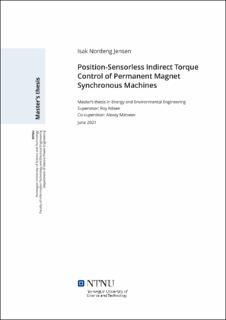| dc.contributor.advisor | Nilsen, Roy | |
| dc.contributor.advisor | Matveev, Alexey | |
| dc.contributor.author | Jensen, Isak Nordeng | |
| dc.date.accessioned | 2021-10-07T17:22:20Z | |
| dc.date.available | 2021-10-07T17:22:20Z | |
| dc.date.issued | 2021 | |
| dc.identifier | no.ntnu:inspera:79771761:59640980 | |
| dc.identifier.uri | https://hdl.handle.net/11250/2788512 | |
| dc.description.abstract | Sensorløse permanentmagnet synkronmotordrifter er i ferd med etablere seg som det foretrukne valget for anvendelser som krever stor grad av sikkerhet, pålitelighet og lav vekt. Dette kan tilskrives fordeler som høy effekt- og momenttetthet, virkningsgrad og pålitelighet og redusert maskinvare-kompleksitet, kostnad og størrelse.
I denne avhandlingen blir en styringsplattform basert på en "system on chip" (SoC) brukt for utvikling og implementering av C++-programvare som muliggjør sensorløs momentstyring av permanentmagnet synkronmaskiner. To metoder for sensorløs styring er implemenert og programmert på SoC-prosessoren og verifisert ved hjelp av en sanntidssimulator som er integrert i FPGAen på SoCen. Begge metodene benytter seg av aktiv fluks-konseptet for rotorposisjon-estimering, men fremgangsmåten som benyttes for å estimere aktiv fluks-vektoren er ulik: Den første metoden benytter seg av den Niemelä-kompenserte spenningsmodellen, mens den andre er basert på spenning- og strøm-modellen.
Det blir demonstert at en unøyaktig estimert stator-resistans resulterer i et fluksestimat som "drifter" og blir unøyaktig over tid, noe som gjør sensorløs styring vanskelig. Begge fluksmodellene som benyttes viser seg å være høyst effektive for sensorløs styring med et unøyaktig resistans-estimat i medium- og høy-hastighetsområdet. Begge modellene muliggjør kryssing av null-turtallsområdet, samt vedvarende kjøring ved lave turtall under 0.1 per unit. Simuleringene blir i utgangspunktet gjennomført med en hastighets-avhenging, kvadratisk lastfunksjon som brukes for modellering av pumper og vifter. Modellene blir imidlertid også verifsert for et scenario hvor en last med konstant moment blir benyttet. Dette indikerer at metodene også er gyldige for anvendelser som heiser og kraner.
Sanntidssimulatoren som har blitt benyttet har vist seg å være et nyttig verktøy i utviklingen og verifiseringen av styringsprogramvare for permanentmagnet synkronmotordrifter. Programvaren som har blitt utviklet kan anvendes på en fysisk motordrift i et laboratorie eller på sanntidssimulatoren, og sistnevnte muliggjør testing av styringsprogrammvaren uten tilgang på en fysisk testrigg. Som en følge av FPGAens høye prosesseringshastighet kan simulatoren gjennomføre simuleringer i sanntid, noe som gjør verifisering av styringsstrategier en adskillig mindre tidkrevende prosess enn hvis konvesjoneller simuleringsverktøy hadde blitt brukt. | |
| dc.description.abstract | Position-sensorless permanent magnet synchronous machine (PMSM) drives are emerging as the state-of-the-art in high-performance safety-critical and weight-sensitive applications due to advantages such as high power and torque density, high efficiency and reliability and reduced hardware complexity, cost and size.
In this thesis, a state-of-the-art system-on-chip (SoC) based embedded controller is used for the development and implementation of C++ software that enables position-sensorless indirect torque control (ITC) of PMSMs. Two fundamental-excitation based methods for sensorless control are developed and programmed on the SoC central processing unit (CPU) and verified using an embedded real-time simulator (ERTS) that is housed by the SoC field-programmable gate array (FPGA). Both methods utilize the active flux concept for rotor position estimation, but the means of which the active flux vector is obtained differs between the two: The first method uses the Niemelä-corrected voltage model, while the second method is based on the voltage-current model.
It is shown that an inaccurately estimated stator resistance results in a flux estimate that drifts and becomes increasingly inaccurate over time, which makes position-sensorless operation without the implementation of specialized flux models impossible. The proposed flux models both prove to be highly effective for sensorless operation with an erroneous resistance estimate in the medium and high speed region. Moreover, both models enable crossing of the zero-speed region and persistent operation at very-low speeds below 0.1 per unit. Simulations are initially performed with a speed-dependent, quadratic load function that is valid for the modelling of pumps and fans, but the models are also verified for a scenario where a constant load torque is applied, suggesting that they are applicable for constant-load applications such as cranes and hoists.
The ERTS proves to be an immensely useful tool in the development of control software for PMSM drives. The control software on the SoC processor is intended to drive either a physical PMSM drive in a laboratory setup or the ERTS, and the latter enables the verification of the sensorless control strategies without accessing an actual PMSM drive test bench. Owing to the real-time nature of the ERTS, due to the high processing capability of the FPGA, simulations can be drastically accelerated and control strategy verification is made a less time-consuming effort than if conventional simulation tools were to be used. | |
| dc.language | eng | |
| dc.publisher | NTNU | |
| dc.title | Position-Sensorless Indirect Torque Control of Permanent Magnet Synchronous Machines | |
| dc.type | Master thesis | |
